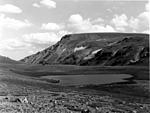Here is a thread on repeat photography of natural (i.e., non-urban) landscapes. There may be another or others like this; if so, then this could be joined with it. Others can post their photos as well, of course.
My background is in vegetation ecology, so I re-take images with that purpose in mind, for people that are interested in the particular scenes, or more commonly, the overall landscape and on-going processes that the scenes represent.
But this is a photography site the last time I checked, so to make it more interesting for photographers, I will post my re-take first, people can critique it anyway they want, then after a while I will post the original scene. I would be happy to explain anything I can about the scene to those interested, but generally I will just say where it is and when it was taken, and what I used. The originals could be from several photographers, dating back to the 1870's. Some of the original photographers were professional photographers, some were not. I will try and pick out the more scenic, aesthetic ones, but could stray from that if it seems worthwhile.
What we can learn from this is how different photographers viewed the landscape, their style, what their relative skill-level was, and how well (or not) I captured the re-take.
So here is the first one:
Unamed lake and ridge along the Buffalo Plateau, near Marston Pass, in the Teton Wilderness in NW Wyoming. September 4, 2018.

On 4 by 5 Ilford Ortho Plus, with a 135-mm Kodak WF Ektar, 1/65 s at F16. The image is cropped a little to match the original, which had a 44-degree horizontal field of view. Scanned from a print on Ilford MG IV Deluxe glossy RC paper, #2 filter.



 Reply With Quote
Reply With Quote

Bookmarks